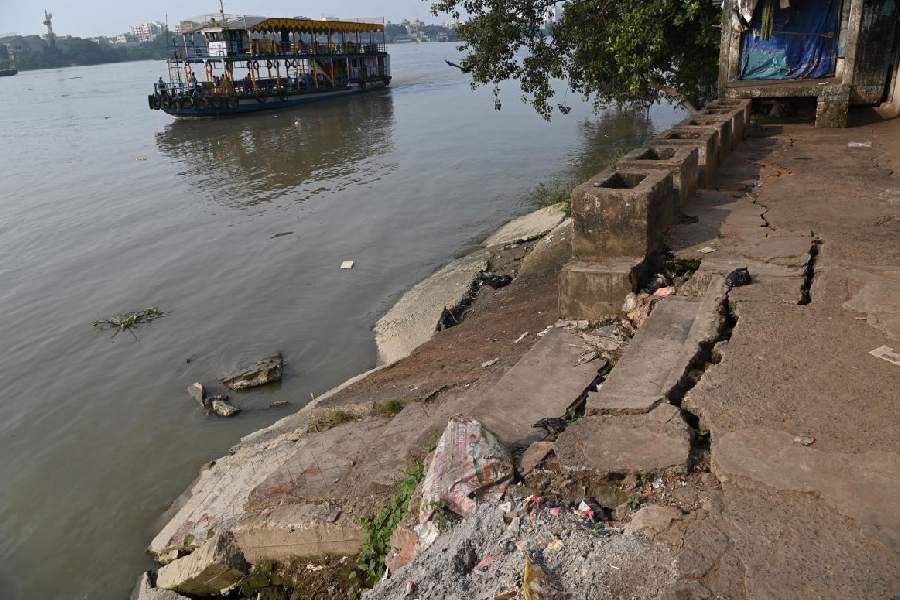The banks of the Hooghly in Calcutta have been eroded in multiple stretches, with the river making deep inroads and almost reaching the land.
A portion of a park has been washed away and stretches of the banks have developed cracks, collapsed and fallen into the river.
The owner of a warehouse along Strand Bank Road, near the Burrabazar circular railway station, said a portion of the embankment behind their warehouse fell into the river a few days before Mahalaya.

Branches of tree was spurned along the river bank near Burrabazar circular rail station to prevent erosion.
The road near Ratan Babu Ghat in Cossipore had started to cave in a few months ago and when repairs by the Calcutta Municipal Corporation (CMC) proved inadequate, the civic body wrote to the state irrigation department seeking their help.
A river scientist blamed the encroachment of the banks, with the accompanying destruction of the natural greenery, for the increasing rate of erosion. Although a natural phenomenon, human activities have helped speed up the erosion along the riverbank in Calcutta, he said.
In the absence of any protective measure from the government, the owners of the warehouses along the riverbank and local residents, many of them living in shanties, have dumped concrete waste, sacks filled with bricks and other waste along the banks to keep the river at bay.
On Wednesday, Metro walked along the riverbank in some stretches. The banks behind the multiple warehouses along Strand Bank Road have been badly damaged. The warehouses now stand within two metres of the river in some stretches.

Broken steps of a ghat near Nimtala Ghat because of erosion.
The boulders along the banks have been broken down and washed away in many places near Nimatala Ghat. Multiple homes are now within a few metres of the river near Ratan Babu Ghat in Cossipore.
A senior official of the CMC said that the entire stretch between Babughat and Ratan Babu Ghat has multiple stretches where erosion has brought the river very close to the land.
“The stretch around Millenium Park has been damaged badly. The erosion has also started to damage the Nimtala Ghat, especially the steps of the ghat,” said the official.
“We tried to take some measures on our own, but they are inadequate. We have written to the state irrigation department about erosion
near Ratan Babu Ghat. Boulder pitching along the banks can be a good step,” said the CMC official.
The owner of a warehouse along the riverbank said that he has witnessed the river advance towards the bank by a few metres in the last two decades.
“This keeps happening slowly. Every time there is a spring tide, the water splashes against the banks and a portion gives way,” said an employee in another warehouse along the riverbank.
Supratim Karmakar, a river scientist, said that while erosion cannot be stopped completely, it can be controlled. Plantation along the riverbank can prevent the erosion.
“But the choice of what kind of plantation should be done is very important and should be done after research. I am also against having concrete guardwalls along the bank. The riverbanks have an ecosystem on their own and concrete guardwalls destroy it,” he said.
Karmakar also blamed indiscriminate encroachment of the banks for speedier erosion.
“The river bank is made of silt and sand. When the water hits the bank, it goes inside. When it goes back, it carries some sand along with it. This creates a vacuum.
The additional load from above, because of encroachment of banks, contributes to subsidence and erosion,” he said.
Kalyan Rudra, a river scientist and also the chairperson of the state pollution control board, said that the CMC should alert the port trust authorities about the erosion of banks.
